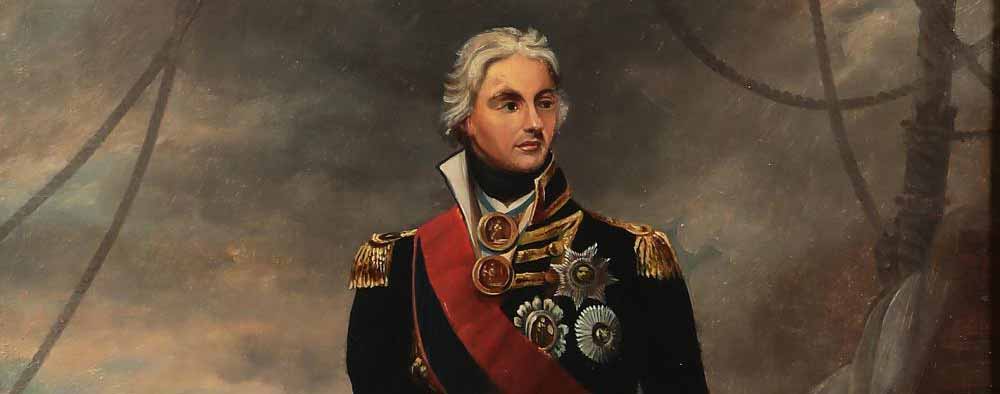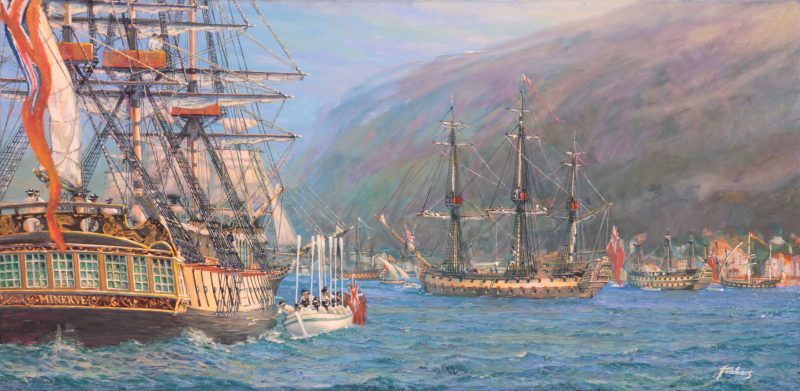Source:Espejo de navegantes
When a defeat of the great British sailor is mentioned, one usually thinks of his failed attempt against Tenerife in 1797, which also cost him his right arm. But there was one other occasion, at least, when he was defeated, albeit incompletely and very honorably for him.
At the end of 1796, the already captain Horacio Nelson, with the position of Commodore, hoisted his insignia on the frigate “Minerve”, accompanied by the “Blanche”.
At about 11 am on December 19, 1796, he ran into two other Spanish frigates, the “Matilde”, not far from Cartagena, under the command of Miguel Gastón de Iriarte, head of the Spanish group, and the “Santa Sabina”, commanded by Jacobo Stuart.
The “Matilde” and the “Blanche” were soon lost on the horizon while fighting, but the main fight was between the “Santa Sabina” and the “Minerve” with Nelson in command, although their commander was George Cockburn.
The British superiority was more than evident, since the “Minerve”, of French origin (launched in Toulon in 1794 and captured by the British the following year), carried 28 guns of 18 pounds, six of 6 and 16 carronades of 32, with a 526-pound broadside, while the “Sabina”, launched in Ferrol in 1781, carried 28 of 18, twelve of 6 and as many swivel guns of 3, useless except at point-blank range in case of boarding and against personnel, with just 306 pounds of broadside, and of a smaller maximum caliber.
Despite the superiority in the artillery of Nelson’s frigate, of more than 5 to 3, the combat lasted for three and a half hours, the Spanish having to surrender, with two dead and 48 wounded, the mizzen pole shot down and the other two about to fall, against seven dead and 33 wounded of the British, but with more luck in the arbor. The respective casualty figures and the duration of the combat clearly show the value and expertise of the Spanish in combat, despite topics as repeated as they are inaccurate and despite their great inferiority.
Nelson was impressed to learn that the enemy commander was nothing less than a Stuart, a descendant of the kings of Scotland and England, so he treated him with all consideration and respect, returning the sword to him. To take possession of the imprisoned “Sabina” he assigned two lieutenants and 40 men, placing her under the command of his faithful friend and subordinate Hardy.
But at about four-thirty in the morning, the “Matilde” appeared under the command of Gastón, who had managed to get rid of the “Blanche”, and came to the aid of his companion, despite being a ship much smaller than the two British, 34 guns and 12 pounds of maximum caliber, with which the combat was resumed.
After half an hour of fire, and with the “Blanche” rejoined with Nelson, another Spanish group attracted by the cannonade was sighted: the frigates “Ceres” and “Perla”, followed at a distance by the great ship with three bridges “Príncipe de Asturias”.
On that note, Nelson understood that he had no choice but to retreat at full sail, a maneuver facilitated by his faithful Hardy (in whose arms he died in Trafalgar) who delayed the Spanish as much as he could with the “Sabina”, which was recovered, as Hardy fell prisoner together with the other officer and the forty British sailors, while the other two frigates pursued Nelson’s, causing them another ten or eleven casualties. But shooting in pursuit caused them to lose speed, due to the recoil of the guns, and the English were finally able to flee. Not to mention that the Spanish frigates, with sizes of 40 and 34 guns, were inferior to the British ones, of 50 and 38, although Nelson’s had suffered heavy casualties and notorious damage. Apart from the fact that they suspected that other English ships would be nearby, turning the tables again.
A gentlemanly Nelson, who had kept Stuart as his sole prisoner, wrote to Gaston, his chief, upon his release and being exchanged for Hardy and the other English prisoners:
“I cannot allow Don Jacobo to return to your side without expressing my admiration for his courageous behavior. To you, who have seen the state of your ship, it is not necessary to prove how impossible it was to prolong the defense. I have lost many brave men in the fight, but with our masts, I was the most fortunate; if it had not been so, it is likely that I would have had the pleasure of meeting you. But God has arranged things differently, for which I am grateful.”
The truth is that the Spanish and British sailors, recent allies in the war against the Convention, had learned to respect and value each other, even if the political vicissitudes returned to face them in bloody combat.
In short, that was a very honorable naval defeat for Nelson, but undoubtedly a severe setback, which other enemies of the great British sailor would have liked to take on, whether they were French, Dutch, or Danish, which again and clearly shows how unfair, inaccurate and partial of many judgments about the Spanish sailors of that time and their expertise in combat. And it is good to remember these facts to properly assess the history and achievements of each other.
Share this article
On This Day
- 1572 Andrés Díaz Venero de Leyva founded the town of Guaduas (Colombia).
- 1578 Brunei becomes a vassal state of Spain.
- 1672 Spanish comic actor Cosme Pérez ("Juan Rana") dies.
- 1693 Painter Claudio Coello dies.
- 1702 The Marquis de la Ensenada was born.
- 1741 Spanish troops break the siege of castle San Felipe in Cartagena de Indias (Colombia).
- 1844 The Royal Order of Access to Historical Archives was promulgated.
- 1898 President Mckinley signed the Joint Resolution, an ultimatum to Spain, which would lead to the Spanish–American War.
History of Spain
26 August 2020
27 January 2021
Communism: Now and Then
23 December 2022
28 July 2021







